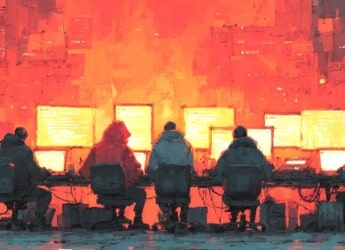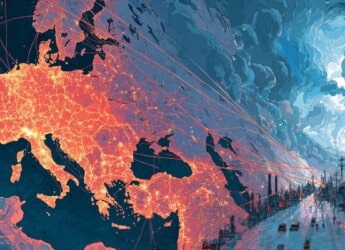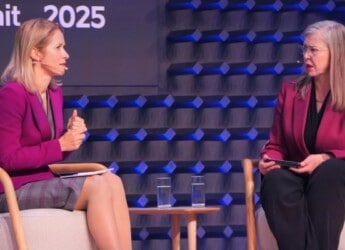Editor’s Note: As the Russo-Ukrainian conflict continues to escalate, the battleground is increasingly defined by not just military operations but also a fierce struggle for control over information. This update, as of August 9, 2024, delves into the multifaceted nature of the conflict, highlighting significant military developments such as Ukrainian advances in Kursk Oblast and strategic strikes on Russian assets. However, the report also underscores a critical dimension of the conflict: the intensifying information warfare. The Kremlin’s aggressive efforts to control the domestic narrative, including new telecommunications restrictions and the suppression of independent media, reflect a deepening authoritarian grip aimed at shaping public perception and stifling dissent. These moves, combined with troubling reports of increased chemical weapon usage by Russian forces, underscore the growing complexity of the conflict. For cybersecurity, information governance, and eDiscovery professionals, understanding these dynamics is essential as the battle for control extends beyond the physical battlefield into the digital and informational realms.
For those seeking to grasp the full scope of this evolving landscape, the complete updates from the Institute for the Study of War serve as an invaluable resource.
Content Assessment: Ukraine Conflict Deepens: Kremlin’s Information Warfare and Media Suppression
Information - 93%
Insight - 94%
Relevance - 92%
Objectivity - 94%
Authority - 95%
94%
Excellent
A short percentage-based assessment of the qualitative benefit expressed as a percentage of positive reception of the recent Russo-Ukrainian conflict update from ComplexDiscovery OÜ based on reporting from the Institute for the Study of War.
Background Note: ComplexDiscovery’s staff offers distinctive perspectives on the Russo-Ukrainian war and Iran-Israel conflict, informed by military experience on the West German, East German, and Czechoslovakian border during the Cold War and in Sinai as part of Camp David Accord compliance activities. This firsthand regional knowledge has been further enhanced by recent staff travels to Eastern European countries, including Estonia, Latvia, Lithuania, and Poland. These visits have provided up-to-date, on-the-ground insights into the current geopolitical climate in regions directly impacted by the ongoing conflict.
Combined with proficiency in cybersecurity, information governance, and eDiscovery, this multifaceted experience enables comprehensive analysis of these conflicts, including the critical impact of cyber warfare, disinformation, and digital forensics on modern military engagements. This unique background positions ComplexDiscovery to provide valuable insights for conflict-related investigations and litigation, where understanding the interplay of technology, data, and geopolitical factors is crucial.
Russo-Ukrainian Conflict Update*
Ukraine Conflict Deepens: Kremlin’s Information Warfare and Media Suppression
ComplexDiscovery Staff
The ongoing Russian offensive and Ukrainian counteroffensive operations continue to unfold with significant developments across multiple fronts. This assessment provides a detailed analysis of military actions and strategic adjustments as of August 9, 2024, focusing on the situation in Kursk Oblast, Ukrainian strikes on Russian assets, escalating Kremlin efforts to control the domestic information space, and other critical developments, including U.S. military assistance to Ukraine and the increasing use of chemical agents by Russian forces.
Ukrainian Military Operations and Russian Countermeasures in Kursk Oblast: On August 9, Russian sources reported that Ukrainian forces had advanced further east in Kursk Oblast. Ukrainian incursions have been noted near the international border, specifically towards Kucherov, roughly one kilometer from the border. These forces have extended as far as Plekhovo, located southeast of Sudzha, along the left bank of the Psyol River. However, reports suggest that Ukrainian forces have likely retracted from their northernmost and westernmost positions, no longer operating as far north or west as initially claimed on August 8. This pullback reflects ongoing Ukrainian tactical adjustments in response to Russian counterattacks.
In response, the Russian military command has been relying primarily on existing units stationed near the international border. These units are composed mainly of conscripts and irregular forces, indicating a strategic choice to avoid redeploying more experienced forces from other critical fronts. The Russian Ministry of Defense (MoD) has deployed additional artillery, multiple launch rocket systems (MLRS), and heavy-tracked vehicles to reinforce defenses in Sudzha Raion, reflecting an increased commitment to stabilizing the situation in the region.
Ukrainian Strikes on Russian Military Assets: Ukrainian forces have maintained their focus on disrupting Russian military logistics and reinforcements through targeted strikes. On August 9, Ukrainian forces successfully struck a Russian military convoy east of Rylsk near Oktyabrskoye in Kursk Oblast. Geolocated footage confirmed the destruction of Russian trucks along the 38K-017 highway, with 14 Ural and KAMAZ covered trucks reportedly transporting Russian reserves. The strike likely resulted in significant Russian casualties, further hindering the Kremlin’s ability to reinforce its positions in Kursk Oblast.
In a broader offensive, Ukrainian forces also targeted a Russian military airfield in Lipetsk Oblast and various military installations in occupied Crimea and Donetsk Oblast. The Ukrainian General Staff reported the destruction of several ammunition warehouses at the Lipetsk airfield, where Russian Su-34, Su-35, and MiG-31 aircraft are based. Satellite imagery and Russian sources confirmed the damage, indicating the effectiveness of the strikes in degrading Russian military infrastructure.
U.S. Military Assistance to Ukraine: Amidst these ongoing operations, the United States Department of Defense announced a new military assistance package for Ukraine on August 9, valued at $125 million. This package, the 63rd tranche provided since August 2021, includes critical supplies such as ammunition for High Mobility Artillery Rocket Systems (HIMARS), 155mm and 105mm artillery rounds, Stinger missiles, Javelin and AT-4 anti-tank systems, Tube-Launched, Optically-Tracked, Wire-Guided (TOW) missiles, and additional equipment. This continued support underscores the U.S. commitment to bolstering Ukraine’s defensive capabilities amidst the ongoing conflict.
Russian Strategic Adjustments and Military Readiness: As Ukrainian operations intensify, the Russian military command faces complex strategic choices. While the Russian forces in Kursk Oblast are primarily composed of less experienced conscripts and irregular units, there is evidence that more seasoned and better-provisioned units are being slowly transferred to the area. A Kremlin-affiliated milblogger suggested that elements from the Russian Northern Grouping of Forces’ 44th Army Corps, originally allocated for offensive operations in northern Kharkiv Oblast, are now operating near Rylsk. This transfer suggests a recognition by the Russian military of the increased significance of the Ukrainian threat in Kursk Oblast.
Despite these adjustments, the pace of reinforcements to Kursk Oblast remains slow, likely due to logistical challenges and the strategic imperative to maintain Russian offensive operations in Eastern Ukraine, particularly in Donetsk and Luhansk Oblasts. The Russian military’s cautious approach underscores the difficulties in balancing defensive and offensive operations across a vast and contested battlefield.
Escalating Information Control and Telecommunications Restrictions: In parallel with its military operations, the Kremlin has significantly escalated its efforts to control the domestic information space. On August 8, President Vladimir Putin signed into law a series of stringent regulations aimed at restricting telecommunications and social media usage. One of the key provisions requires owners of social media channels with over 10,000 followers to register their personal details with Roskomnadzor, Russia’s federal censor, by November 1. This law is part of a broader campaign by the Kremlin to codify pro-Kremlin behavioral norms into law and establish tighter control over the digital landscape.
The new legislation also imposes limits on the number of SIM cards per person—20 for Russian citizens and 10 for foreigners and stateless persons. Additionally, it forbids the use of untraceable payment methods for communications services, effectively eliminating anonymous telecommunications in Russia. These measures represent a significant tightening of the Kremlin’s grip on information and communications, reflecting heightened concerns about the influence of Western social media and the potential for dissent.
On August 9, Roskomnadzor announced that it had blocked the Signal encrypted messaging service for non-compliance with Russian law. This action follows increasing reports from Russian users of severe throttling of YouTube speeds, likely an effort by the government to push users towards Kremlin-controlled platforms where information can be more easily monitored and censored. The throttling of YouTube, one of the most popular platforms for independent news and commentary, highlights the Kremlin’s intent to limit access to alternative viewpoints and ensure the dominance of state-controlled narratives.
These developments indicate a broader strategy by the Russian government to consolidate control over the domestic information space. By restricting access to independent sources of information and pushing users towards platforms that the state can monitor and influence, the Kremlin is seeking to suppress dissent and reinforce its narrative, particularly as the war in Ukraine continues to unfold.
Increasing Use of Chemical Agents by Russian Forces: Adding to the complexities on the ground, there are growing concerns regarding the Russian military’s use of chemical agents in Ukraine, potentially in violation of the Chemical Weapons Convention (CWC). Ukrainian officials reported on August 9 that Russian forces have increasingly used chemical attacks, particularly employing K-51 and RG-VO hand grenades with riot control agents that are prohibited by the CWC. The scale of these attacks is alarming, with 358 incidents recorded in July 2024 alone, and a total of 3,570 incidents since February 15, 2023. This escalation in chemical weapon usage poses significant risks to both Ukrainian military personnel and civilians, further complicating the conflict’s humanitarian dimensions.
Broader Implications: The recent developments underscore the multifaceted nature of the conflict, with both military and information warfare playing critical roles. The Ukrainian military’s ability to strike deep into Russian-held territory and the Kremlin’s intensifying efforts to control the domestic narrative reflect the high stakes of the ongoing conflict. As both sides continue to adapt their strategies, the situation remains fluid, with significant implications for the broader trajectory of the war and regional stability. The Russian government’s actions, both on the battlefield and within its own borders, suggest an increasingly authoritarian approach to managing the challenges it faces, with potentially far-reaching consequences for Russian society and its role in the international community.
News Sources
As a leading source for cybersecurity, information governance, and legal discovery insights, including international investigations and litigation, ComplexDiscovery OÜ recognizes the importance of awareness regarding alleged and documented criminal acts, particularly in the context of the Russia-Ukraine conflict. While we, following the lead of the Institute for the Study of War (ISW), do not provide detailed coverage of war crimes in our primary reports, we encourage professionals within the eDiscovery ecosystem to stay informed about these activities. This awareness is crucial for understanding potential future legal actions and responsibilities.
Detailed Reporting with Maps for August 9, 2024, from the ISW – Mouseover to Scroll
2024-08-09-Russian Offensive Campaign AssessmentReview the Detailed Reporting and Maps PDF
About the Institute for the Study of War Research Methodology
ISW’s research methodology relies on both primary and secondary sources, enabling researchers to develop a comprehensive understanding of the situation on the ground. In order to analyze military and political developments in any given area, ISW’s research analysts must wholly understand the systems of enemy and friendly forces. They must also understand the population demographics, physical terrain, politics, and history of that area. This lays the analytical foundation for understanding the reasons for particular developments and fulfilling their assigned research objectives. ISW analysts also spend time in places like Iraq, Afghanistan, and elsewhere in order to gain a better understanding of the security and political situation and to evaluate the implementation of current strategies and policies. Our researchers compile data and analyze trends, producing a granular analysis of developments in areas of research, producing an accurate, high-resolution, timely, and thorough picture of the situation. ISW’s research methodology guarantees its success and commitment to improving the nation’s ability to execute military operations, achieve strategic objectives, and respond to emerging problems that may require the use of American military power.
About the Institute for the Study of War
The Institute for the Study of War advances an informed understanding of military affairs through reliable research, trusted analysis, and innovative education. They are committed to improving the nation’s ability to execute military operations and respond to emerging threats in order to achieve U.S. strategic objectives. ISW is a non-partisan, non-profit, public policy research organization.
Learn more, get involved, and contribute today.
Additional Reading
- From Dissent to OSINT? Understanding, Influencing, and Protecting Roles, Reputation, and Revenue
- [Annual Update] International Cyber Law in Practice: Interactive Toolkit
- Data Embassies: Sovereignty, Security, and Continuity for Nation-States
Assisted by GAI and LLM Technologies
* Sourced and shared with direct express permission from the Institute for the Study of War (ISW).
Source: ComplexDiscovery OÜ


























